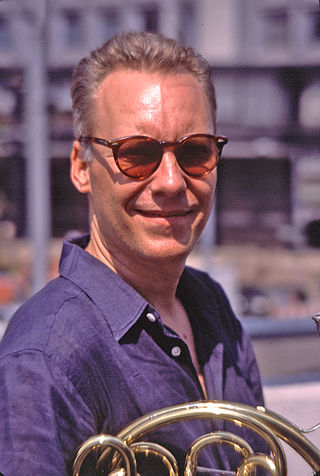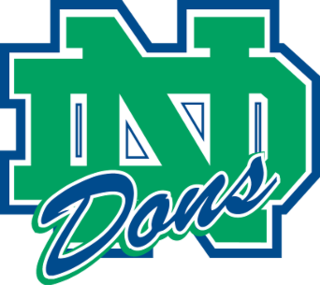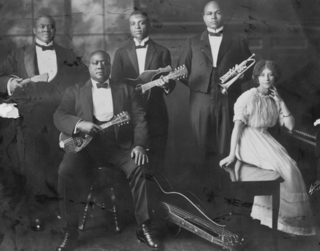Related Research Articles

Wayne Horvitz is an American composer, keyboardist and record producer. He came to prominence in the Downtown scene of 1980s and '90s New York City, where he met his future wife, the singer, songwriter and pianist Robin Holcomb. He is noted for working with John Zorn's Naked City among others. Horvitz has since relocated to the Seattle, Washington area where he has several ongoing groups and has worked as an adjunct professor of composition at Cornish College of the Arts.
The Notre Dame Victory March is the fight song for the University of Notre Dame.

Ron Dewar was an American jazz saxophone and clarinet player who grew up in Plainfield, Illinois and worked in the Chicago area. His father, Robert Dewar, worked in a bowling alley. His mother, Ruth Jahneke Dewar taught music. His younger brothers Roger and Randy grew up to perform and teach music.

Tom Varner is an American jazz horn player and composer.

Notre Dame College Preparatory is a male-only Roman Catholic secondary school founded in Niles, Illinois in 1955 by the Congregation of Holy Cross. It is located in the Roman Catholic Archdiocese of Chicago.The school was built by Belli & Belli of Chicago.
William Overton Smith was an American clarinetist and composer. He worked extensively in modern classical music, third stream and jazz, and was perhaps best known for having played with pianist Dave Brubeck intermittently from the 1940s to the early 2000s. Smith frequently recorded jazz under the name Bill Smith, but his classical compositions are credited under the name William O. Smith.

Elizabeth Brown Larsen is a contemporary American classical composer. Along with composer Stephen Paulus, she is a co-founder of the Minnesota Composers Forum, now the American Composers Forum.
Steve Sample Sr. was a bandleader, arranger, composer and jazz educator. For more than 30 years, Sample was a professor in the Music Department of the University of Alabama, where he directed the Jazz Ensembles and taught music theory, arranging and jazz related courses. Sample trained many notable jazz musicians during his long tenure at Alabama, including Gary Wheat, Birch Johnson, Kelley O'Neal, Chris Gordon, Mervyn Warren, Cedric Dent, Beth Gottlieb, Mart Avant, Dick Aven and Ray Reach. He was respected by his peers as one of the finest jazz educators in the United States. On September 26, 2008, Sample was inducted into the Alabama Jazz Hall of Fame for his contributions to jazz education.

Siemon Edward Top is a Dutch composer.
Chuck Deardorf was an American musician. He was best known for playing double bass and bass guitar with the Deardorf Peterson Group. He also headed the jazz department at the Cornish College of the Arts.
John Serry Jr. is an American jazz pianist and composer, as well as a composer of contemporary classical music works that feature percussion, on which he also doubles. He is a son of the accordionist and composer John Serry. His debut solo album was 'Exhibition', for which he received a Grammy Nomination for his composition, 'Sabotage'.

Carla Scaletti is an American harpist, composer, music technologist and the inventor of the Kyma Sound Design Environment as well as president of Symbolic Sound.
Michael Holmes is an American classical saxophonist, originally from Findlay, Ohio.
Roger Briggs is an American composer, conductor, pianist, and educator.

Michael Nicolella is an American classical guitarist and composer. Described as an iconoclast, he is known for his versatile, adventurous and eclectic approach to repertoire, including the incorporation of electric guitar into his concert programs and recordings. Nicolella's repertoire ranges from the Baroque to the present. His most recent recording is his own arrangement of the complete cello suites of Johann Sebastian Bach; while his past four recordings focused on contemporary music, including his own compositions, alongside those of Toru Takemitsu, Elliott Carter, Luciano Berio, Hans Werner Henze and Steve Reich. He has championed music by such emerging composers as Laurence Crane and Jacob ter Veldhuis and has premiered many works written for him by other composers, including: Joshua Kohl,, David Mesler, Christopher DeLaurenti and John Fitz Rogers, who in 2001 wrote the forty-five-minute piece Transit for Nicolella, scored for electric guitar and computer generated sound. His own compositions include works for solo guitar, chamber music with guitar, a classical guitar concerto, and an electric guitar concerto. His most recent major composition for soprano, guitar and orchestra, The Flame of the Blue Star of Twilight, was premiered by the Northwest Symphony Orchestra and soprano Alexandra Picard in April 2012. He has performed and collaborated with a wide range of groups and artists including: violinist Gil Shaham, rock singer Jon Anderson, best known for his work as lead vocalist in the progressive rock band Yes, broadway legends Bernadette Peters and Brian Stokes Mitchell, the Seattle Guitar Trio, jazz singer Johnaye Kendrick, classical music comedians Igudesman and Joo and is a frequent guest with the Seattle Symphony. Nicolella is a graduate of Yale University, Berklee College of Music and the Accademia Musicale Chigiana. He is currently based in Seattle, where he serves on the music faculty of Cornish College of the Arts. He is married to the painter Ann Gale.

Joseph Brazil was an American jazz saxophonist and educator. Local musicians and touring acts performed in his basement. He taught jazz at Garfield High School, co-founded the Black Music curriculum at the University of Washington, and founded the Black Academy of Music in Seattle. He appeared on the albums Om by John Coltrane and Mystic Voyage by Roy Ayers.
John Garvey was an American musician, orchestra leader, and academic who played viola in the Walden String Quartet for 23 seasons, introduced a jazz curriculum at the University of Illinois, and created its Jazz Big Band which he led until his retirement from the university in 1991. The jazz band dominated collegiate jazz festival awards in its early days and in 1969 was chosen by the state department to tour the USSR and Eastern Europe. Many members of Garvey's jazz bands went on to successful careers as professional musicians and academics.
Peter and Will Anderson are identical twin American jazz saxophonists and clarinetists, composers and arrangers, and leaders of their own trio and quintet.

The Whangdoodle Entertainers, sometimes referred to as the Whangdoodle Trio, Whangdoodle Quartet, Whangdoodle Quintet, Whangdoodle Orchestra, and Whangdoodle Ensemble was an American jazz and ragtime band formed in Seattle, Washington. They routinely performed throughout the Seattle area from approximately 1907 to 1925.
Frank D. Waldron (1890-1955) was an American jazz cornetist, alto saxophonist, trumpeter, composer, bandleader, and music teacher who lived in Seattle, Washington. He was born in San Francisco, California in 1890 and eventually moved to the Pacific Northwest by the beginning of World War I. When he initially moved to Washington, he began his performance career at Camp Lewis—known as Fort Lewis today—playing dance music at the local pavilion attended by soldiers and company. By 1915, he joined the Whangdoodle Entertainers, playing alongside pianist Coty Jones. Waldron and the Whangdoodle Entertainers became notable playing in underground clubs and speakeasies, typical of Prohibition-era jazz music. Following his time with the Whangdoodle Entertainers, he joined the Odean Jazz Orchestra. Later, the Odean Jazz Orchestra would be one of very few black bands to perform at Nanking Café in downtown Seattle which rarely incorporated the integration of black musicians in the night scene. In 1919 Waldron opened The Waldron School of Trumpet and Saxophone where he taught students such as Buddy Catlett and Quincy Jones. Waldron being an expert in his field, taught his pupils the basics of embouchure and phrasing, sight-reading, tonguing, furthermore even improvisation and ear-training. These specialized techniques were staple artistic skill for musicians to achieve before moving forward in their musical endeavors.
References
- ↑ Lidral, Karel (1986). Four Pieces by James Knapp for Jazz Ensemble: Stylistic Analysis and Performance Guides. Urbana, IL: Doctoral Thesis. p. 14.
- ↑ Carey, Joseph (1986). Big Noise from Notre Dame. Notre Dame, Indiana: University of Notre Dame Press. pp. 70, 72. ISBN 0-268-00677-6.
- ↑ Carey, Joseph (1986). Big Noise from Notre Dame. Notre Dame, Indiana: University of Notre Dame Press. p. 87. ISBN 0-268-00677-6.
- ↑ Armbruster, Kurt (2011). Before Seattle Rocked: A City and its Music. Seattle, Washington: University of Washington Press. p. 295. ISBN 978-0-295-99113-9.
- ↑ Armbruster, Kurt (2011). Before Seattle Rocked: A City and its Music. Seattle, Washington: University of Washington Press. p. 297. ISBN 978-0-295-99113-9.
- ↑ Darroch, Lynn (2016). Rhythm in the Rain: Jazz in the Pacific Northwest. Portland, Oregon: Ooligan Press. p. 85. ISBN 9781932010817.
- ↑ Bargreen, Melinda (12 December 1983). "Cage pushes musical frontier too far". The Seattle Times. p. 31.
- ↑ de Barros, Paul (3 April 1986). "Curtain Falls on a Unique Jazz Orchestra". The Seattle Times. p. G1. Retrieved 17 December 2021.
- ↑ de Barros, Paul (1993). Jackson Street After Hours: The Roots of Jazz in Seattle. Seattle, Washington: Sasquatch Books. p. 204. ISBN 0-912365-86-2.